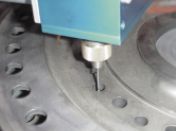E-Archive
Articles
in Vol. 2 - August Issue - Year 2001
Internal Peening

Two different rotation heads in order to accommodate all lance sizes

GT-Baiker Metal Finishing Pte Ltd is a Singaporean Peening Job Shop and mainly works for the Aviation Industry. It holds a source approval from the world's largest aircraft manufacturer and is ISO 9001 certified.
Internal peening is certainly the most demanding of all peening applications. The required machinery specification to integrate this process can be very high. The operator must be able to program with a greater accuracy and must be aware of the special Almen test procedures used for internal processes.
There are a large variety of possible internal peening applications. It can be the treatment of dove tails and slots on disks or hubs, oil holes on engine shafts, any kind of bore or hard to reach area to be shot peened in order to increase the fatigue life. Therefore, being a job shop the equipment has to be evaluated very carefully.
Wide Range of Internal Peening Lances
For a company which is offering the peening as a service, new parts will have to be treated on a freuquent basis. Therefore one has to have access to many different lances, starting from very tiny lances for Ø2.5mm bores up to lances for holes with diameters over 200mm and lengths of up to 1000mm. GT-Baiker Metal Finishing Pte Ltd can chose from over 100 standard lances, depending on requirement. The lances are mostly made of tungsten carbide. However, for some very abrasives media, lances with a Vickers hardness of 2800 are available.
Machine for Internal Peening Processes
In comparison to a machine which just has to execute external peening, the requirements are much higher for internal peening. The lance-workpiece distance is for internal peening applications just a fraction of what is normally used for external treatments. In extreme cases, a Ø2.3mm lance is chosen for a Ø2.5mm bore.
In order to use such small nozzles the machine must be equipped with a precision media flow rate control. Because if the media flow is not uniform, smaller lances tend to clog immediately and the process has to be interrupted. In order to cope with all the different shapes of the work-pieces, it is fundamental that lances have the same kind of movement flexibility as available for external peening. A system was chosen in which the rotation heads for the lances are installed onto the standard gantry robot. This allows the freedom of movement within 4 axis. Since the CNC axis can interpolate between each other, complicated shapes such as curved slots on hubs can be treated with the highest accuracy. If the lance leaves its rotation tolerance, the machine will immediately shut down and indicate the fault in a protocol.
Almen Test Strip Procedure for Internal Peening
Also the Almen test strip procedure is a bit more complicated for internal peening applications. Depending on the case, shaded stripes have to be used. Since for external application normally the whole strip is peened, a correlation has to be made to know what intensity has to be reached with the lance if only a certain area of the strip is treated.
For Information:
GT-Baiker Metal Finishing PTE LTD
10 Loyang Street
Singapore 508844
Tel: +65 6542 8993
Fax: +65 65429896
e-mail: gtind@cyberway.com.sg



























